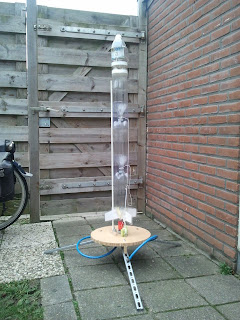It's been a while since my last post but I'm back in water rocketry again.
I'm planning to build some drop away boosters for the last rocket I made. I want to build the boosters out of spliced pairs so I needed to find a strong glue that will stick to pet. There's a glue called PL Premium that's often used for splicing but unfortunately it's not available here in Holland. I've looked in several stores for other PU glues (PL Premium is also a PU glue) with the same specifications as PL Premium but didn't find a match. So I just bought a glue named "Tangit M400" a PU glue that looked promising to me. I made a asymmetric splice out of 2 coke bottles and the next day I did a hydro pressure test, unexpectedly it held up to 100 psi and there was no sign of any leaks, I could not test at higher pressures because I'm still stuck with the old bicycle pump, I'll probably get a new one soon so I can do a real burst test on the splice.
 |
| The test splice, next time I'll use a little less glue. |
For the drop away booster system there need to be tubes at the sustainer and pins at the boosters. I tested 3 glues to attach tubes to a pet bottle; Tangit M400, Pattex PL600 and Pattex Power Fix. The PL600 is also a PU glue and the Power Fix is a polymer based glue.
 |
| The 3 tubes glued to a bottle. from left to right: Tangit M400, Pattex PL600 and Pattex Power Fix. |
The wires you see in the picture were used to attach a luggage scale with a bucket underneath, when testing the bucket was slowly filled with water to increase the force on the tubes.
 |
| the test setup. not pretty but it works. |
At first i tested the Power Fix glue, it held up to ~6 kg.
The PL600 gave up at ~7 kg.
With the Tangit M400 I filled the whole bucket with water and it was still holding, I pulled the bucket down until the scale was at 14 kg but still no sign of the tube coming loose, I removed the bucket and and hung a loop of rope to the hook of the scale and placed my foot in the loop, at 27 kg the rope broke!
 |
| Pattex Power Fix: 6 kg |
 |
| Pattex PL600: 7 kg |
 |
| Tangit M400: 27 kg |
The pictures above are coming from a video I made during the test, they all are the last frame before the tubes came loose or the rope broke.
I still don't know how much it would hold but I'm pretty sure the M400 glue is strong enough both for splicing and for the tubes and pins of the boosters...














